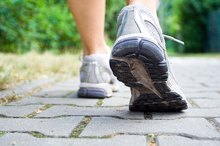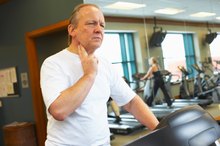Lack of Oxygen During Running
When you start running, your muscles use energy stored in the form of adenosine triphosphate. But these energy stores deplete quickly. The most efficient way of replacing ATP requires oxygen, so you’ll start to breathe faster to compensate for your lack of oxygen 2. Also, your heart beats faster so it can pump more oxygen-rich blood, and the blood vessels in your muscles expand to handle the increased blood flow.
Significance
If you run often, your cardiovascular system will be strong and efficient, which means it can send oxygen to your muscles quickly. Consequently, you’ll be able to run for a long time. But if you're not fit, your cardiovascular system won’t be able to obtain and deliver oxygen quickly and may cause early fatigue.
Effects
Why Am I So Tired After I Work Out?
Learn More
At a certain point, a lack of oxygen makes it impossible to keep running 2. You might feel lightheaded and as if you’re about to faint. As your body fights to take in more oxygen to meet its enhanced needs, it turns to anaerobic respiration -- which doesn’t require oxygen -- to fuel your muscles. A byproduct of this is lactic acid, which decreases the efficiency of muscles and can cause muscle cramps. While pushing yourself to exercise hard is good, if you feel these symptoms you should stop running. Walk slowly and breathe deep to allow your body to restore its oxygen levels.
- At a certain point, a lack of oxygen makes it impossible to keep running 2.
- While pushing yourself to exercise hard is good, if you feel these symptoms you should stop running.
Solution
Running regularly will improve your cardiovascular system, which will lead to greater endurance. The key is to challenge your cardiovascular system without pushing your body too hard. If you're new to running, start with a brisk walk to warm up the muscles and then run for a short time. Your goal should be to reach an intensity level at which your breathing is rapid but you still can converse normally without stopping to catch your breath. If you do this regularly, over time you’ll be able to run for longer periods without experiencing a lack of oxygen 2.
- Running regularly will improve your cardiovascular system, which will lead to greater endurance.
- If you're new to running, start with a brisk walk to warm up the muscles and then run for a short time.
Expert Insight
What Happens During Exercise at 90% of Maximum Heart Rate?
Learn More
Some runners train in oxygen-poor, high-altitude climates to force their bodies to adjust to a lack of oxygen 2. This strengthens their cardiovascular system even more. Running at high altitudes stimulates the production of red blood cells, which deliver oxygen to muscles. Consequently, the increased number of red blood cells improves muscle endurance.
- Some runners train in oxygen-poor, high-altitude climates to force their bodies to adjust to a lack of oxygen 2.
- Running at high altitudes stimulates the production of red blood cells, which deliver oxygen to muscles.
Related Articles
References
- University of New Mexico: The "Talk Test"
- T Pub: Effects of Lack of Oxygen
- Things to Know When Using Oxygen Therapy. American Lung Association. August 23, 2018
- The Long-Term Oxygen Treatment Trial Research Group. A Randomized Trial of Long-Term Oxygen for COPD with Moderate Desaturation. The New England Journal of Medicine. 2016;375(17):1617-1627. doi:10.1056/NEJMoa1604344.
- American Lung Association. Supplemental Oxygen. 2017.
- Shah SA, Velardo C, Farmer A, Tarassenko L. Exacerbations in Chronic Obstructive Pulmonary Disease: Identification and Prediction Using a Digital Health System. Eysenbach G, ed. Journal of Medical Internet Research. 2017;19(3):e69. doi:10.2196/jmir.7207.
- Turan O, Ure I, Turan PA. Erectile dysfunction in COPD patients. Chron Respir Dis. 2016;13(1):5–12. doi:10.1177/1479972315619382
- Traveling with Oxygen. American Lung Association. October 3, 2018
- Nishimura M. High-flow nasal cannula oxygen therapy in adults. J Intensive Care. 2015;3(1):15. Published 2015 Mar 31. doi:10.1186/s40560-015-0084-5
- Abdo WF, Heunks LM. Oxygen-induced hypercapnia in COPD: myths and facts. Crit Care. 2012;16(5):323. Published 2012 Oct 29. doi:10.1186/cc11475
- American Thoracic Society. Patient Education Information Series. Oxygen Therapy. 2016.
Writer Bio
Stan Mack is a business writer specializing in finance, business ethics and human resources. His work has appeared in the online editions of the "Houston Chronicle" and "USA Today," among other outlets. Mack studied philosophy and economics at the University of Memphis.









